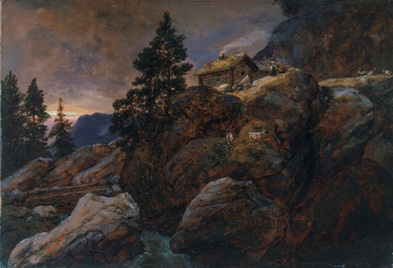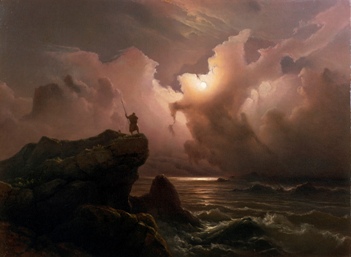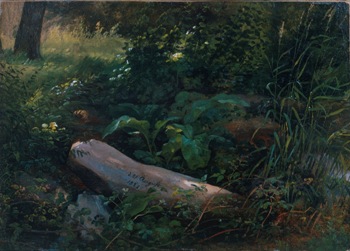Forests, Rocks, Torrents: Norwegian and Swiss Landscapes, National Gallery | reviews, news & interviews
Forests, Rocks, Torrents: Norwegian and Swiss Landscapes, National Gallery
Forests, Rocks, Torrents: Norwegian and Swiss Landscapes, National Gallery
They celebrated their native land but with imaginations too firmly grounded
Wednesday, 20 July 2011
The National Gallery has in recent years made a speciality of examining the hitherto unexamined. Just for starters, a surprise hit some years ago was Spanish Still Lifes, 2007 saw Renoir Landscapes (who knew?), last year there was the ravishing Christen Kobke, star of the Danish Golden Age, and just this spring New York’s Ashcan School, all with committed scholarship throwing light on the internationally disregarded.
In a gallery full of stormy seas, Alpine passes (with the occasional mountain goat), fast-moving streams and huge skies, two more unfamiliar geographies are on view. We may suspect that Switzerland is home to more than centuries of worthy stability and the cuckoo clock, and Norway, after centuries of occupation by her neighbours, more than Nordic commonsense, Northern Lights and all that oil; but hands up whoever can name the outstanding 19th-century painters of Alpine and fjord landscapes that inhabit the museums of Oslo and Wintherthur?
Johann Christian Dahl probably does just make it, but Johann Gottfried Steffan? Peder Balke? Francois Diday? Adam-Wolfgang Toppfer? Knud Baade? Even the most substantial of all, Alexandre Calame? They're all here making their presence known, mostly for the first time in London.
In this selection from the specialist collection of New York-based Norwegian-American lawyer Asbjorn Lunde, we are shown a romantically inclined, occasionally picturesque and often sublime response to land and seascape. A familiar 19th-century point of view is here brushed in by almost completely unfamiliar artists. Jean Jacques Rousseau’s 18th-century rhapsodic commentary on nature is a philosophic bedrock: “Imagine the variety, the grandeur, the beauty of a thousand stunning vistas; the pleasure of seeing all around you… an altogether different nature, and finding oneself in a new world.”
The combination of Switzerland and Norway throws up surprising similarities in spite of contradictory geographies. Yes, Switzerland is landlocked but awash with lakes and rivers - Lake Lucerne is here a star, Calame admiring its blue, green and turquoise waters from its coastal cliffs (main picture above: Cliffs of Seelisberg, Lake Lucerne, c 1861) - and Norway provides as much coastline as glacier and mountain pass.
 All these waterfalls, vast skies, rocky paths and mountain peaks, these wilderness vistas, are punctuated only occasionally by signs of human involvement, even cultivation. A determined Fisherman at Derwentwater bent against the wind, is wading through whatever nature throws up in the scenic choreography of Thomas Fearnley’s excursion to England’s mini-wilderness in 1837. In Robert Zund’s Storm Study, sheep, shepherd and dog flee for cover under a darkening sky. There are vertiginously clambering goats in Johann Christian Dahl’s Mountain Farm, 1854 (pictured right), the humble farmhouse itself perched atop a huge rock, testifying to rural tenacity. And are those sheep, goats or rocks in Dahl’s view of the Feigumfuss in Lysterfford, 1848? It is a mix of all three contemplated by a lone shepherd, who looks a very long way from home.
All these waterfalls, vast skies, rocky paths and mountain peaks, these wilderness vistas, are punctuated only occasionally by signs of human involvement, even cultivation. A determined Fisherman at Derwentwater bent against the wind, is wading through whatever nature throws up in the scenic choreography of Thomas Fearnley’s excursion to England’s mini-wilderness in 1837. In Robert Zund’s Storm Study, sheep, shepherd and dog flee for cover under a darkening sky. There are vertiginously clambering goats in Johann Christian Dahl’s Mountain Farm, 1854 (pictured right), the humble farmhouse itself perched atop a huge rock, testifying to rural tenacity. And are those sheep, goats or rocks in Dahl’s view of the Feigumfuss in Lysterfford, 1848? It is a mix of all three contemplated by a lone shepherd, who looks a very long way from home. Most of the paintings are based on acute observation, though legend can be called upon with just the placement of a figure: Knud Baade’s achingly romantic Scene from the Era of Norwegian Sagas, 1850 (pictured left), is that archetypal subject - the helmeted warrior, spear in hand, on a rocky promontory at the edge of the sea, irradiated by the dying light, and seemingly about to be engulfed by the vastness of encroaching cloud. Not so surprising perhaps, as Baade was persuaded by his compatriot Dahl to come to Dresden, where Dahl was not only teaching but sharing premises with the German Caspar David Friedrich, the great German painter who endowed landscape with divine significance.
Most of the paintings are based on acute observation, though legend can be called upon with just the placement of a figure: Knud Baade’s achingly romantic Scene from the Era of Norwegian Sagas, 1850 (pictured left), is that archetypal subject - the helmeted warrior, spear in hand, on a rocky promontory at the edge of the sea, irradiated by the dying light, and seemingly about to be engulfed by the vastness of encroaching cloud. Not so surprising perhaps, as Baade was persuaded by his compatriot Dahl to come to Dresden, where Dahl was not only teaching but sharing premises with the German Caspar David Friedrich, the great German painter who endowed landscape with divine significance.A rediscovery is Peder Balke, a Norwegian born into rural poverty who achieved a peripatetic career. Balke studied in Oslo, Stockholm and Dresden, walked the Norwegian landscape, received a royal commission in Paris and eventually painted for himself in relative but prosperous obscurity. His brilliantly wilful seascapes in tones of black, white and grey are sombre in mood, intimately grand and beguilingly lively in execution.
 Everybody travelled, and several were naturally seduced – who wouldn’t be after all those northern nights? – by sunlit Italy. A selection of Fearnley and Dahl’s euphoric Italian views prove a piquant contrast to all the geological explorations and stormy carry-on. And there are surprises: Dahl’s exquisitely detailed, mesmerising The Grosser Garten Dresden, 1822 (pictured right), anticipates the hallucinatory close-ups of pre-Raphaelite and Ruskinian gardens.
Everybody travelled, and several were naturally seduced – who wouldn’t be after all those northern nights? – by sunlit Italy. A selection of Fearnley and Dahl’s euphoric Italian views prove a piquant contrast to all the geological explorations and stormy carry-on. And there are surprises: Dahl’s exquisitely detailed, mesmerising The Grosser Garten Dresden, 1822 (pictured right), anticipates the hallucinatory close-ups of pre-Raphaelite and Ruskinian gardens. This anthology is certainly a good place to cool down if the sun ever comes out in our monsoon summer; but the overall impact is perhaps a little tame. These major minor masters are patriotically wedded to the beauties and grandeurs of their native landscapes, but their imaginations are at times just too firmly grounded.
- Forests, Rocks, Torrents: Norwegian and Swss Landscapes from the Lunde Collection at the National Gallery until 18 September
Explore topics
Share this article
more Visual arts
 Yinka Shonibare: Suspended States, Serpentine Gallery review - pure delight
Weighty subject matter treated with the lightest of touch
Yinka Shonibare: Suspended States, Serpentine Gallery review - pure delight
Weighty subject matter treated with the lightest of touch
 Jane Harris: Ellipse, Frac Nouvelle-Aquitaine MÉCA, Bordeaux review - ovals to the fore
Persistence and conviction in the works of the late English painter
Jane Harris: Ellipse, Frac Nouvelle-Aquitaine MÉCA, Bordeaux review - ovals to the fore
Persistence and conviction in the works of the late English painter
 Sargent and Fashion, Tate Britain review - portraiture as a performance
London’s elite posing dressed up to the nines
Sargent and Fashion, Tate Britain review - portraiture as a performance
London’s elite posing dressed up to the nines
 Zineb Sedira: Dreams Have No Titles, Whitechapel Gallery review - a disorientating mix of fact and fiction
An exhibition that begs the question 'What and where is home?'
Zineb Sedira: Dreams Have No Titles, Whitechapel Gallery review - a disorientating mix of fact and fiction
An exhibition that begs the question 'What and where is home?'
 Yoko Ono: Music of the Mind, Tate Modern review - a fitting celebration of the early years
Acknowledgement as a major avant garde artist comes at 90
Yoko Ono: Music of the Mind, Tate Modern review - a fitting celebration of the early years
Acknowledgement as a major avant garde artist comes at 90
 Unravel: The Power and Politics of Textiles in Art, Barbican review - the fabric of dissent
An ambitious exploration of a neglected medium
Unravel: The Power and Politics of Textiles in Art, Barbican review - the fabric of dissent
An ambitious exploration of a neglected medium
 When Forms Come Alive, Hayward Gallery review - how to reduce good art to family fun
Seriously good sculptures presented as little more than playthings or jokes
When Forms Come Alive, Hayward Gallery review - how to reduce good art to family fun
Seriously good sculptures presented as little more than playthings or jokes
 Entangled Pasts 1768-now, Royal Academy review - an institution exploring its racist past
After a long, slow journey from invisibility to agency, black people finally get a look in
Entangled Pasts 1768-now, Royal Academy review - an institution exploring its racist past
After a long, slow journey from invisibility to agency, black people finally get a look in
 Barbara Kruger, Serpentine Gallery review - clever, funny and chilling installations
Exploring the lies, deceptions and hyperbole used to cajole, bully and manipulate us
Barbara Kruger, Serpentine Gallery review - clever, funny and chilling installations
Exploring the lies, deceptions and hyperbole used to cajole, bully and manipulate us
 Richard Dorment: Warhol After Warhol review - beyond criticism
A venerable art critic reflects on the darkest hearts of our aesthetic market
Richard Dorment: Warhol After Warhol review - beyond criticism
A venerable art critic reflects on the darkest hearts of our aesthetic market
 Dineo Seshee Raisibe Bopape: (ka) pheko ye / the dream to come, Kiasma, Helsinki review - psychic archaeology
The South African artist evokes the Finnish landscape in a multisensory installation
Dineo Seshee Raisibe Bopape: (ka) pheko ye / the dream to come, Kiasma, Helsinki review - psychic archaeology
The South African artist evokes the Finnish landscape in a multisensory installation
 Paul Cocksedge: Coalescence, Old Royal Naval College review - all that glitters
An installation explores the origins of a Baroque masterpiece
Paul Cocksedge: Coalescence, Old Royal Naval College review - all that glitters
An installation explores the origins of a Baroque masterpiece

Add comment